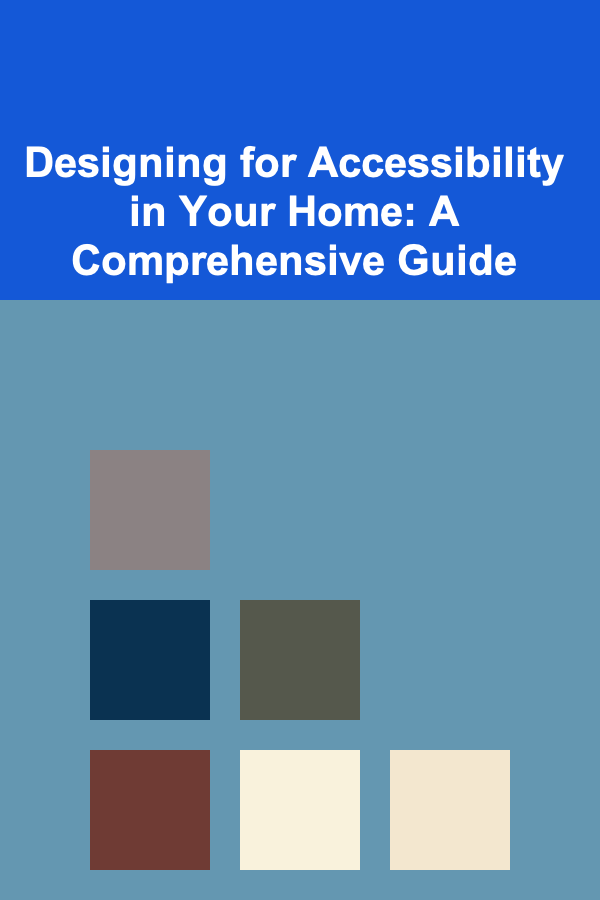
Designing for Accessibility in Your Home: A Comprehensive Guide
ebook include PDF & Audio bundle (Micro Guide)
$12.99$7.99
Limited Time Offer! Order within the next:

Creating an accessible home is not just about compliance with regulations; it's about creating a welcoming and functional space for everyone, regardless of their age, abilities, or disabilities. Accessibility is a spectrum, and designing with it in mind benefits not only those with mobility impairments, visual or auditory challenges, or cognitive differences, but also families with young children, older adults, and even individuals recovering from temporary injuries. A thoughtfully designed accessible home increases safety, comfort, and independence, allowing individuals to age in place gracefully and participate fully in daily life. This comprehensive guide explores the key principles and practical considerations involved in designing an accessible home.
Understanding Accessibility: Beyond Compliance
Accessibility, at its core, is about ensuring that environments, products, and services are usable by people of all abilities. It encompasses a wide range of considerations, from physical access to sensory and cognitive accessibility. While building codes often specify minimum requirements for accessibility features, true accessible design goes beyond these bare minimums to create a truly inclusive and user-friendly environment.
Here are some key aspects to consider:
- Physical Accessibility: Focuses on removing physical barriers that prevent individuals with mobility impairments from navigating and using a space. This includes things like ramps, wider doorways, accessible bathrooms, and adaptable kitchens.
- Sensory Accessibility: Addresses the needs of individuals with visual or auditory impairments. This may involve incorporating features like high-contrast signage, tactile indicators, and assistive listening devices.
- Cognitive Accessibility: Focuses on making information and environments easier to understand and navigate for individuals with cognitive differences, such as learning disabilities or dementia. This can involve using clear and concise language, providing consistent wayfinding, and minimizing distractions.
- Age-Friendly Design: Incorporates principles that make a home suitable for older adults, allowing them to age in place safely and comfortably. This often overlaps with accessibility principles, but also includes considerations like good lighting, slip-resistant flooring, and easy-to-use appliances.
It's also crucial to remember that accessibility needs are highly individual. What works well for one person may not work for another. Therefore, it's essential to engage in open communication with individuals with disabilities to understand their specific needs and preferences.
Key Design Principles for Accessible Homes
Several core principles guide the design of accessible homes. Understanding and applying these principles will result in a more functional and inclusive living space.
1. Universal Design
Universal Design aims to create products and environments that are usable by all people, to the greatest extent possible, without the need for adaptation or specialized design. It's about designing proactively for diversity, rather than reactively accommodating individual needs. The seven principles of Universal Design, developed by the Center for Universal Design at North Carolina State University, provide a useful framework:
- Equitable Use: The design is useful and marketable to people with diverse abilities.
- Flexibility in Use: The design accommodates a wide range of individual preferences and abilities.
- Simple and Intuitive Use: Use of the design is easy to understand, regardless of the user's experience, knowledge, language skills, or current concentration level.
- Perceptible Information: The design communicates necessary information effectively to the user, regardless of ambient conditions or the user's sensory abilities.
- Tolerance for Error: The design minimizes hazards and the adverse consequences of accidental or unintended actions.
- Low Physical Effort: The design can be used efficiently and comfortably and with a minimum of fatigue.
- Size and Space for Approach and Use: Appropriate size and space is provided for approach, reach, manipulation, and use regardless of user's body size, posture, or mobility.
2. Adaptability
Adaptable design involves incorporating features that can be easily modified to meet changing needs over time. This is particularly important for aging in place, as individuals' abilities may decline as they get older. Examples of adaptable features include adjustable-height countertops, removable cabinets under sinks, and reinforced walls for grab bar installation.
3. Safety and Security
Accessibility and safety are closely intertwined. Accessible design should prioritize safety by minimizing hazards, providing clear and intuitive wayfinding, and incorporating features that help prevent accidents. This includes things like good lighting, slip-resistant flooring, and accessible emergency exits.
4. Comfort and Convenience
An accessible home should be comfortable and convenient to use for everyone. This means paying attention to details like ergonomics, user-friendly controls, and adequate storage space. It also means creating a welcoming and aesthetically pleasing environment that promotes well-being.
5. Aesthetics
Accessibility doesn't have to mean sacrificing aesthetics. Accessible design can be beautiful and stylish. There are many attractive and functional accessibility products available, and it's possible to create a home that is both accessible and visually appealing. Focus on integrating accessibility features seamlessly into the overall design.
Room-by-Room Accessibility Considerations
1. Entrances and Exits
The entrance to your home is the first impression. Make it accessible to everyone.
- Ramps: If there are steps leading to the entrance, a ramp is essential for individuals using wheelchairs or other mobility devices. Ramps should have a gentle slope (typically 1:12) and handrails on both sides. Ensure the ramp surface is slip-resistant and wide enough to accommodate wheelchairs comfortably.
- Doorways: Widen doorways to at least 32 inches clear width to accommodate wheelchairs and walkers. Consider using swing-clear hinges to maximize the opening width.
- Thresholds: Minimize thresholds or use beveled thresholds to prevent tripping hazards.
- Doorknobs and Handles: Replace traditional doorknobs with lever handles or push/pull hardware, which are easier to operate for individuals with limited hand strength or dexterity.
- Lighting: Ensure adequate lighting at entrances, including both ambient and task lighting. Consider using motion-sensor lights for added convenience and safety.
- Covered Entry: Provide a covered area at the entrance to protect users from the elements while unlocking the door or waiting for assistance.
2. Kitchen
The kitchen is often the heart of the home. Make it accessible and safe for everyone.
- Countertops: Install adjustable-height countertops or provide a variety of countertop heights to accommodate different users. Consider having a lowered section for seated food preparation.
- Sinks: Choose a sink with a shallow bowl and knee clearance underneath. Insulate the drainpipes to prevent burns.
- Faucets: Install lever-operated faucets or touchless faucets, which are easier to use for individuals with limited hand strength.
- Appliances: Select appliances with front controls and easy-to-read displays. Consider installing a side-opening oven or a cooktop with a pull-out shelf.
- Storage: Use pull-out shelves, lazy Susans, and other storage solutions to make it easier to reach items in cabinets and pantries. Ensure that frequently used items are stored within easy reach.
- Clearance: Ensure adequate clearance (at least 5 feet turning radius) for wheelchairs to maneuver around the kitchen.
3. Bathrooms
Bathrooms are one of the most important areas to consider for accessibility.
- Toilet: Install a comfort-height toilet (17-19 inches) for easier transfers. Reinforce the walls around the toilet for grab bar installation.
- Grab Bars: Install grab bars near the toilet and in the shower or bathtub. Grab bars should be securely mounted and provide adequate support.
- Shower/Bathtub: Consider a zero-entry shower (roll-in shower) to eliminate the need to step over a threshold. If a bathtub is preferred, choose one with a low threshold and install a bath bench or seat.
- Shower Controls: Install easy-to-reach shower controls and a handheld showerhead.
- Sink: Choose a sink with knee clearance underneath and a shallow bowl. Insulate the drainpipes to prevent burns.
- Mirror: Install a tilting mirror or a mirror that extends lower to the countertop.
- Clearance: Ensure adequate clearance (at least 5 feet turning radius) for wheelchairs to maneuver around the bathroom.
4. Bedrooms
Create a comfortable and safe bedroom environment.
- Bed Height: Choose a bed height that allows for easy transfers.
- Clearance: Ensure adequate clearance around the bed for wheelchairs and other mobility devices.
- Lighting: Provide adequate lighting, including bedside lamps and overhead lighting. Consider using dimmer switches to adjust the lighting levels.
- Closets: Install adjustable closet rods and shelves to maximize storage space.
- Flooring: Choose slip-resistant flooring.
- Controls: Place light switches and other controls within easy reach from the bed. Consider smart home technology for remote control of lights and other devices.
5. Living Areas
Design living areas that are comfortable and accessible for all.
- Furniture: Choose furniture that is comfortable and easy to get in and out of. Avoid furniture with low seats or sharp edges.
- Pathways: Ensure clear pathways throughout the living area, free from obstacles.
- Lighting: Provide adequate lighting, including both ambient and task lighting.
- Flooring: Choose slip-resistant flooring. Avoid using throw rugs, which can be tripping hazards.
- Controls: Position light switches, outlets, and other controls at accessible heights.
- Technology: Consider using assistive technology, such as voice-activated controls, to make it easier to operate lights, appliances, and other devices.
6. Stairs and Elevators
If your home has multiple levels, consider accessibility solutions for stairs.
- Stairs: Stairs should have consistent riser heights and tread depths. Install handrails on both sides of the stairs, extending beyond the top and bottom steps. Consider adding tactile markings to the edges of the steps for individuals with visual impairments.
- Elevators: If possible, install a residential elevator. Elevators provide a safe and convenient way for individuals with mobility impairments to access different levels of the home.
- Stair Lifts: If an elevator is not feasible, consider installing a stair lift. Stair lifts can be used to transport individuals up and down stairs.
Specific Considerations for Different Disabilities
1. Mobility Impairments
For individuals with mobility impairments, the primary focus is on removing physical barriers and providing ample space for maneuvering.
- Wheelchair Accessibility: Ensure doorways are wide enough, ramps have appropriate slopes, and there is adequate turning space in all rooms.
- Assistive Devices: Plan for the use of assistive devices such as walkers, canes, and scooters. Ensure there is storage space for these devices.
- Reach Ranges: Design storage and controls within comfortable reach ranges.
- Transfer Surfaces: Provide stable and accessible transfer surfaces in bathrooms and bedrooms.
2. Visual Impairments
For individuals with visual impairments, accessibility focuses on providing clear and perceptible information and minimizing hazards.
- Lighting: Maximize natural light and provide adequate artificial lighting, especially in areas with potential hazards.
- High Contrast: Use high-contrast color schemes to make objects and surfaces easier to distinguish.
- Tactile Markings: Use tactile markings on appliances, controls, and other surfaces to provide information by touch.
- Auditory Signals: Incorporate auditory signals for appliances, alarms, and other devices.
- Wayfinding: Provide clear and consistent wayfinding cues throughout the home.
- Minimize Glare: Reduce glare from surfaces such as floors and countertops.
3. Auditory Impairments
For individuals with auditory impairments, accessibility focuses on providing visual alerts and minimizing background noise.
- Visual Alarms: Install visual alarms for fire, carbon monoxide, and other emergencies.
- Vibrating Alerts: Use vibrating alerts for doorbells, phones, and other notifications.
- Assistive Listening Devices: Consider using assistive listening devices to improve sound quality.
- Visual Communication: Plan for visual communication methods, such as writing boards or video calls.
- Minimize Echo: Use sound-absorbing materials to reduce echo and reverberation.
4. Cognitive Differences
For individuals with cognitive differences, accessibility focuses on making information and environments easier to understand and navigate.
- Clear and Concise Communication: Use clear and concise language in signage and instructions.
- Consistent Wayfinding: Provide consistent and intuitive wayfinding cues throughout the home.
- Minimize Distractions: Reduce clutter and visual distractions.
- Routine and Predictability: Establish routines and predictable environments.
- Memory Aids: Use memory aids such as labels, calendars, and checklists.
- Safety Features: Install safety features such as stove knob covers and automatic shut-off devices.
Retrofitting for Accessibility: Adapting Existing Homes
While designing a new home for accessibility is ideal, retrofitting an existing home is often necessary. Retrofitting involves making modifications to an existing home to improve its accessibility. This can range from simple changes, such as replacing doorknobs with lever handles, to more complex renovations, such as widening doorways or installing a ramp. When retrofitting, it's important to prioritize the most critical accessibility features and to work with qualified professionals who have experience in accessible design.
Here are some common retrofitting projects:
- Widening Doorways: This may involve removing door frames and installing wider doors.
- Installing Ramps: Ramps can be installed at entrances or exits to provide access for individuals using wheelchairs or other mobility devices.
- Modifying Bathrooms: Bathroom modifications may include installing grab bars, replacing a bathtub with a roll-in shower, and raising the toilet height.
- Remodeling Kitchens: Kitchen remodeling may involve installing adjustable-height countertops, lowering the sink, and replacing appliances with accessible models.
- Improving Lighting: Adding or upgrading lighting can improve visibility and safety.
- Replacing Flooring: Replacing slippery flooring with slip-resistant flooring can reduce the risk of falls.
When planning a retrofitting project, it's helpful to conduct an accessibility audit to identify areas that need improvement. An accessibility audit involves evaluating the home's accessibility features and identifying potential barriers. You can conduct your own audit or hire a qualified professional to do it for you.
Resources and Funding
Designing and retrofitting for accessibility can be a significant investment. However, there are resources available to help offset the costs.
- Government Programs: Many government programs offer financial assistance for home modifications that improve accessibility. These programs may be available at the federal, state, and local levels.
- Nonprofit Organizations: Several nonprofit organizations provide grants or low-interest loans for home modifications.
- Tax Deductions: Some home modifications may be tax deductible as medical expenses.
- Home Equity Loans: Home equity loans can be used to finance home modifications.
Here are some helpful resources:
- The Americans with Disabilities Act (ADA): Provides information about accessibility requirements for public accommodations. (https://www.ada.gov/)
- The Center for Universal Design: Offers information about the principles of universal design. (https://projects.ncsu.edu/ncsu/design/cud/index.htm)
- National Association of Home Builders (NAHB): Offers the Certified Aging-in-Place Specialist (CAPS) designation for professionals who specialize in designing and remodeling homes for aging in place. (https://www.nahb.org/)
Conclusion: Creating a Home for Everyone
Designing for accessibility is an investment in the future. It's about creating a home that is welcoming, safe, and functional for everyone, regardless of their abilities. By embracing the principles of universal design, adaptability, and safety, you can create a home that meets the needs of all members of your household and allows you to age in place gracefully. Remember that accessibility is not just about compliance with regulations; it's about creating a truly inclusive and user-friendly environment that enhances the quality of life for everyone.
Take the time to assess your needs, explore your options, and work with qualified professionals to create an accessible home that meets your specific requirements. With careful planning and attention to detail, you can create a home that is both beautiful and functional, and that will serve you well for years to come.

How to Optimize Lighting in Your Fitness Area
Read More
How to Set Up a DIY Bar for Your Next Home Party
Read More
How to Stage a Vacant Home to Make It Feel Inviting
Read More
How to Use Hidden Storage in Furniture to Keep Your Home Clutter-Free
Read More
How to Grasp the Concept of Justice
Read More
How to Choose the Right Gear for Your Extreme Sport
Read MoreOther Products

How to Optimize Lighting in Your Fitness Area
Read More
How to Set Up a DIY Bar for Your Next Home Party
Read More
How to Stage a Vacant Home to Make It Feel Inviting
Read More
How to Use Hidden Storage in Furniture to Keep Your Home Clutter-Free
Read More
How to Grasp the Concept of Justice
Read More